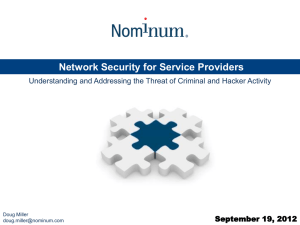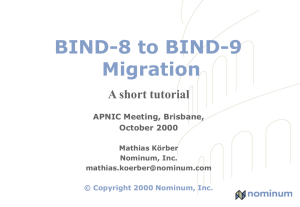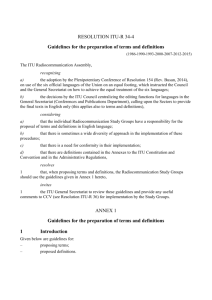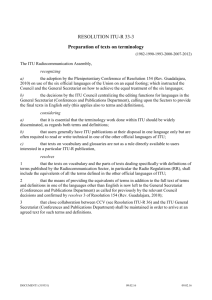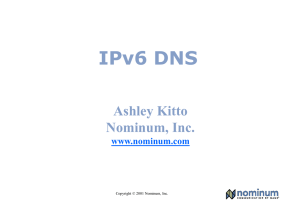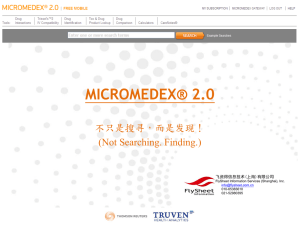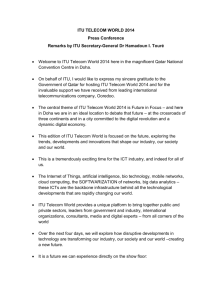The Domain Name System
advertisement
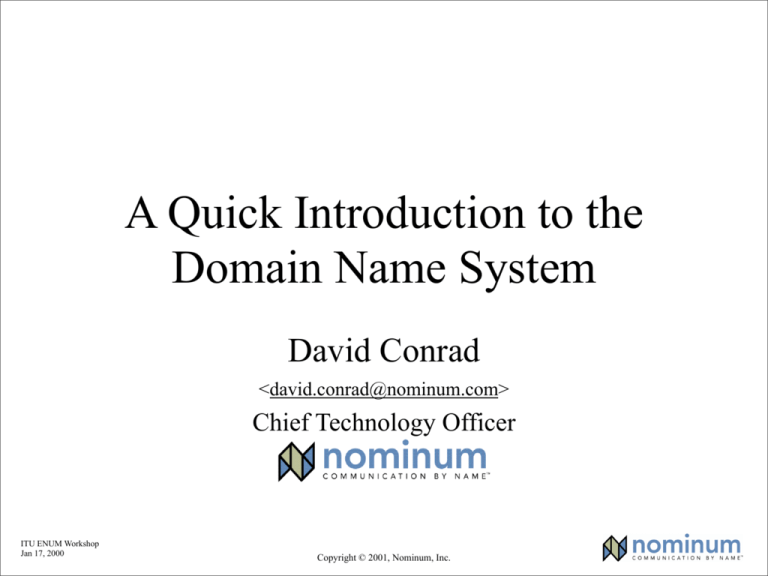
A Quick Introduction to the Domain Name System David Conrad <david.conrad@nominum.com> Chief Technology Officer ITU ENUM Workshop Jan 17, 2000 Copyright © 2001, Nominum, Inc. Overview • • • • Introduction to the DNS DNS Components DNS Structure and Hierarchy The DNS in Context ITU ENUM Workshop Jan 17, 2000 Copyright © 2001, Nominum, Inc. The DNS is… • The “Domain Name System” – Created in 1983 by Paul Mockapetris (RFCs 1034 and 1035), modified, updated, and enhanced by a myriad of subsequent RFCs • What Internet users use to reference anything by name on the Internet • The mechanism by which Internet software translates names to addresses and vice versa ITU ENUM Workshop Jan 17, 2000 Copyright © 2001, Nominum, Inc. A Quick Digression: Names versus Addresses • An address is how you get to an endpoint – Typically, hierarchical (for scaling): • 950 Charter Street, Redwood City CA, 94063 • 204.152.187.11, +1-650-381-6003 • A “name” is how an endpoint is referenced – Typically, no structurally significant hierarchy • “David”, “Tokyo”, “itu.int” ITU ENUM Workshop Jan 17, 2000 Copyright © 2001, Nominum, Inc. The DNS is also… • A lookup mechanism for translating objects into other objects • A globally distributed, loosely coherent, scalable, reliable, dynamic database • Comprised of three components – A “name space” – Servers making that name space available – Resolvers (clients) which query the servers about the name space ITU ENUM Workshop Jan 17, 2000 Copyright © 2001, Nominum, Inc. DNS as a Lookup Mechanism • Users generally prefer names to numbers • Computers prefer numbers to names • DNS provides the mapping between the two – I have “x”, give me “y” • DNS is NOT a directory service – No way to search the database • No easy way to add this functionality ITU ENUM Workshop Jan 17, 2000 Copyright © 2001, Nominum, Inc. DNS as a Database • Keys to the database are “domain names” – www.foo.com, 18.in-addr.arpa, 6.4.e164.arpa • Over 100,000,000 domain names stored • Each domain name contains one or more attributes – Known as “resource records” • Each attribute individually retrievable ITU ENUM Workshop Jan 17, 2000 Copyright © 2001, Nominum, Inc. Global Distribution • Data is maintained locally, but retrievable globally – No single computer has all DNS data • DNS lookups can be performed by any device • Remote DNS data is locally cachable to improve performance ITU ENUM Workshop Jan 17, 2000 Copyright © 2001, Nominum, Inc. Loose Coherency • The database is always internally consistent – Each version of a subset of the database (a zone) has a serial number • The serial number is incremented on each database change • Changes to the master copy of the database are replicated according to timing set by the zone administrator • Cached data expires according to timeout set by zone administrator ITU ENUM Workshop Jan 17, 2000 Copyright © 2001, Nominum, Inc. Scalability • No limit to the size of the database – One server has over 20,000,000 names • Not a particularly good idea • No limit to the number of queries – 24,000 queries per second handled easily • Queries distributed among masters, slaves, and caches ITU ENUM Workshop Jan 17, 2000 Copyright © 2001, Nominum, Inc. Reliability • Data is replicated – Data from master is copied to multiple slaves • Clients can query – Master server – Any of the copies at slave servers • Clients will typically query local caches • DNS protocols can use either UDP or TCP – If UDP, DNS protocol handles retransmission, sequencing, etc. ITU ENUM Workshop Jan 17, 2000 Copyright © 2001, Nominum, Inc. Dynamicity • Database can be updated dynamically – Add/delete/modify of any record • Modification of the master database triggers replication – Only master can be dynamically updated • Creates a single point of failure ITU ENUM Workshop Jan 17, 2000 Copyright © 2001, Nominum, Inc. Overview • Introduction to the DNS • DNS Components – The name space – The servers – The resolvers • DNS Structure and Hierarchy • The DNS in Context ITU ENUM Workshop Jan 17, 2000 Copyright © 2001, Nominum, Inc. The Name Space • The name space is the structure of the DNS database – An inverted tree with the root node at the top • Each node has a label – The root node has a null label, written as “” ITU ENUM Workshop Jan 17, 2000 Copyright © 2001, Nominum, Inc. An Analogy – E.164 • Root node maintained by the ITU (call it “+”) • Top level nodes = country codes (1, 81, etc) • Second level nodes = regional codes (1-808, 81-3, etc.) ITU ENUM Workshop Jan 17, 2000 Copyright © 2001, Nominum, Inc. Labels • Each node in the tree must have a label – A string of up to 63 8 bit bytes • The DNS protocol makes NO limitation on what binary values are used in labels – RFCs 852 and 1123 define legal characters for “hostnames” • A-Z, 0-9, and “-” only with a-z and A-Z treated as the same • • Sibling nodes must have unique labels The null label is reserved for the root node ITU ENUM Workshop Jan 17, 2000 Copyright © 2001, Nominum, Inc. Domain Names • A domain name is the sequence of labels from a node to the root, separated by dots (“.”s), read left to right – The name space has a maximum depth of 127 levels – Domain names are limited to 255 characters in length • A node’s domain name identifies its position in the name space ITU ENUM Workshop Jan 17, 2000 Copyright © 2001, Nominum, Inc. Subdomains • One domain is a subdomain of another if its apex node is a descendant of the other’s apex node • More simply, one domain is a subdomain of another if its domain name ends in the other’s domain name – So sales.nominum.com is a subdomain of • nominum.com • com – nominum.com is a subdomain of com ITU ENUM Workshop Jan 17, 2000 Copyright © 2001, Nominum, Inc. Delegation • Administrators can create subdomains to group hosts – According to geography, organizational affiliation or any other criterion • An administrator of a domain can delegate responsibility for managing a subdomain to someone else – But this isn’t required • The parent domain retains links to the delegated subdomain – The parent domain “remembers” who it delegated the subdomain to ITU ENUM Workshop Jan 17, 2000 Copyright © 2001, Nominum, Inc. Delegation Creates Zones • Each time an administrator delegates a subdomain, a new unit of administration is created – The subdomain and its parent domain can now be administered independently – These units are called zones – The boundary between zones is a point of delegation in the name space • Delegation is good: it is the key to scalability ITU ENUM Workshop Jan 17, 2000 Copyright © 2001, Nominum, Inc. Dividing a Domain into Zones nominum.com domain nominum.com zone ams.nominum.com zone rwc.nominum.com zone ITU ENUM Workshop Jan 17, 2000 Copyright © 2001, Nominum, Inc. Overview • Introduction to the DNS • DNS Components – The name space – The servers – The resolvers • DNS Structure and Hierarchy • The DNS in Context ITU ENUM Workshop Jan 17, 2000 Copyright © 2001, Nominum, Inc. Name Servers • Name servers store information about the name space in units called “zones” – The name servers that load a complete zone are said to “have authority for” or “be authoritative for” the zone • Usually, more than one name server are authoritative for the same zone – This ensures redundancy and spreads the load • Also, a single name server may be authoritative for many zones ITU ENUM Workshop Jan 17, 2000 Copyright © 2001, Nominum, Inc. Name Servers and Zones 128.8.10.5 serves data for both nominum.com and isc.org zones 202.12.28.129 serves data for nominum.com zone only 204.152.187.11 serves data for isc.org zone only ITU ENUM Workshop Jan 17, 2000 Name Servers 128.8.10.5 Zones nominum.com 202.12.28.129 isc.org 204.152.187.11 Copyright © 2001, Nominum, Inc. Types of Name Servers • Two main types of servers – Authoritative – maintains the data • Master – where the data is edited • Slave – where data is replicated to – Caching – stores data obtained from an authoritative server – The most common name server implementation (BIND) combines these two into a single process • Other types exist… • No special hardware necessary ITU ENUM Workshop Jan 17, 2000 Copyright © 2001, Nominum, Inc. Name Server Architecture • You can think of a name server as part: – database server, answering queries about the parts of the name space it knows about (i.e., is authoritative for), – cache, temporarily storing data it learns from other name servers, and – agent, helping resolvers and other name servers find data that other name servers know about ITU ENUM Workshop Jan 17, 2000 Copyright © 2001, Nominum, Inc. Name Server Architecture Zone Name Server Process Authoritative Data (primary master and slave zones) From disk Cache Data (responses from other name servers) Agent (looks up queries on behalf of resolvers) ITU ENUM Workshop Jan 17, 2000 Copyright © 2001, Nominum, Inc. data file Zone transfer Master server Authoritative Data Name Server Process Authoritative Data (primary master and slave zones) Response Cache Data (responses from other name servers) Agent (looks up queries on behalf of resolvers) ITU ENUM Workshop Jan 17, 2000 Copyright © 2001, Nominum, Inc. Query Resolver Using Other Name Servers Name Server Process Authoritative Data (primary master and slave zones) Cache Data (responses from other name servers) Agent (looks up queries on behalf of resolvers) ITU ENUM Workshop Jan 17, 2000 Response Response Query Copyright © 2001, Nominum, Inc. Arbitrary name server Query Resolver Cached Data Name Server Process Authoritative Data (primary master and slave zones) Response Cache Data (responses from other name servers) Agent (looks up queries on behalf of resolvers) ITU ENUM Workshop Jan 17, 2000 Copyright © 2001, Nominum, Inc. Query Resolver Overview • Introduction to the DNS • DNS Components – The name space – The servers – The resolvers • DNS Structure and Hierarchy • The DNS in Context ITU ENUM Workshop Jan 17, 2000 Copyright © 2001, Nominum, Inc. Name Resolution • Name resolution is the process by which resolvers and name servers cooperate to find data in the name space • To find information anywhere in the name space, a name server only needs the names and IP addresses of the name servers for the root zone (the “root name servers”) – The root name servers know about the top-level zones and can tell name servers whom to contact for all TLDs ITU ENUM Workshop Jan 17, 2000 Copyright © 2001, Nominum, Inc. Name Resolution • A DNS query has three parameters: – A domain name (e.g., www.nominum.com), • Remember, every node has a domain name! – A class (e.g., IN), and – A type (e.g., A) • A name server receiving a query from a resolver looks for the answer in its authoritative data and its cache – If the answer isn’t in the cache and the server isn’t authoritative for the answer, the answer must be looked up ITU ENUM Workshop Jan 17, 2000 Copyright © 2001, Nominum, Inc. The Resolution Process • Let’s look at the resolution process step-bystep: annie.west.sprockets.com ping www.nominum.com. ITU ENUM Workshop Jan 17, 2000 Copyright © 2001, Nominum, Inc. The Resolution Process • The workstation annie asks its configured name server, dakota, for www.nominum.com’s address dakota.west.sprockets.com What’s the IP address of www.nominum.com? annie.west.sprockets.com ping www.nominum.com. ITU ENUM Workshop Jan 17, 2000 Copyright © 2001, Nominum, Inc. The Resolution Process • The name server dakota asks a root name server, m, for www.nominum.com’s address m.root-servers.net dakota.west.sprockets.com What’s the IP address of www.nominum.com? annie.west.sprockets.com ping www.nominum.com. ITU ENUM Workshop Jan 17, 2000 Copyright © 2001, Nominum, Inc. The Resolution Process • The root server m refers dakota to the com name servers • This type of response is called a “referral” m.root-servers.net dakota.west.sprockets.com annie.west.sprockets.com ping www.nominum.com. ITU ENUM Workshop Jan 17, 2000 Copyright © 2001, Nominum, Inc. Here’s a list of the com name servers. Ask one of them. The Resolution Process • The name server dakota asks a com name server, f, for www.nominum.com’s address What’s the IP address of www.nominum.com? m.root-servers.net dakota.west.sprockets.com f.gtld-servers.net annie.west.sprockets.com ping www.nominum.com. ITU ENUM Workshop Jan 17, 2000 Copyright © 2001, Nominum, Inc. The Resolution Process • The com name server f refers dakota to the nominum.com name servers Here’s a list of the nominum.com name servers. Ask one of them. m.root-servers.net dakota.west.sprockets.com f.gtld-servers.net annie.west.sprockets.com ping www.nominum.com. ITU ENUM Workshop Jan 17, 2000 Copyright © 2001, Nominum, Inc. The Resolution Process • The name server dakota asks an nominum.com name server, ns1.sanjose, for www.nominum.com’s address What’s the IP address of www.nominum.com? m.root-servers.net dakota.west.sprockets.com ns1.sanjose.nominum.net f.gtld-servers.net annie.west.sprockets.com ping www.nominum.com. ITU ENUM Workshop Jan 17, 2000 Copyright © 2001, Nominum, Inc. The Resolution Process • The nominum.com name server ns1.sanjose responds with www.nominum.com’s address m.root-servers.net dakota.west.sprockets.com Here’s the IP address for www.nominum.com ns1.sanjose.nominum.net annie.west.sprockets.com ping www.nominum.com. ITU ENUM Workshop Jan 17, 2000 Copyright © 2001, Nominum, Inc. f.gtld-servers.net The Resolution Process • The name server dakota responds to annie with www.nominum.com’s address Here’s the IP address for www.nominum.com m.root-servers.net dakota.west.sprockets.com ns1.sanjose.nominum.net f.gtld-servers.net annie.west.sprockets.com ping www.nominum.com. ITU ENUM Workshop Jan 17, 2000 Copyright © 2001, Nominum, Inc. Resolution Process (Caching) • After the previous query, the name server dakota now knows: – The names and IP addresses of the com name servers – The names and IP addresses of the nominum.com name servers – The IP address of www.nominum.com • Let’s look at the resolution process again annie.west.sprockets.com ping ftp.nominum.com. ITU ENUM Workshop Jan 17, 2000 Copyright © 2001, Nominum, Inc. Resolution Process (Caching) • The workstation annie asks its configured name server, dakota, for ftp.nominum.com’s address m.root-servers.net dakota.west.sprockets.com What’s the IP address of ftp.nominum.com? ns1.sanjose.nominum.net f.gtld-servers.net annie.west.sprockets.com ping ftp.nominum.com. ITU ENUM Workshop Jan 17, 2000 Copyright © 2001, Nominum, Inc. Resolution Process (Caching) • dakota has cached an NS record indicating ns1.sanjose is an nominum.com name server, so it asks it for ftp.nominum.com’s address What’s the IP address of ftp.nominum.com? m.root-servers.net dakota.west.sprockets.com ns1.sanjose.nominum.net f.gtld-servers.net annie.west.sprockets.com ping ftp.nominum.com. ITU ENUM Workshop Jan 17, 2000 Copyright © 2001, Nominum, Inc. Resolution Process (Caching) • The nominum.com name server ns1.sanjose responds with ftp.nominum.com’s address m.root-servers.net dakota.west.sprockets.com Here’s the IP address for ftp.nominum.com ns1.sanjose.nominum.net f.gtld-servers.net annie.west.sprockets.com ping ftp.nominum.com. ITU ENUM Workshop Jan 17, 2000 Copyright © 2001, Nominum, Inc. Resolution Process (Caching) • The name server dakota responds to annie with ftp.nominum.com’s address Here’s the IP address for ftp.nominum.com m.root-servers.net dakota.west.sprockets.com ns1.sanjose.nominum.net f.gtld-servers.net annie.west.sprockets.com ping ftp.nominum.com. ITU ENUM Workshop Jan 17, 2000 Copyright © 2001, Nominum, Inc. What can be Resolved? • Any name in the name space • Class – Internet (IN), Chaos (CH), Hesiod (HS) • Type – – – – – ITU ENUM Workshop Jan 17, 2000 Address (A, AAAA, A6) Pointer (PTR, NAPTR) Aliases (CNAME, DNAME) Security related (TSIG, SIG, NXT, KEY) Etc. Copyright © 2001, Nominum, Inc. Overview • • • • Introduction to the DNS DNS Components DNS Structure and Hierarchy The DNS in Context ITU ENUM Workshop Jan 17, 2000 Copyright © 2001, Nominum, Inc. DNS Structure and Hierarchy • The DNS imposes no constraints on how the DNS hierarchy is implemented except: – A single root – The label restrictions • If a site is not connected to the Internet, it can use any domain hierarchy it chooses – Can make up whatever TLDs you want • Connecting to the Internet implies use of the existing DNS hierarchy ITU ENUM Workshop Jan 17, 2000 Copyright © 2001, Nominum, Inc. Top-level Domain (TLD) Structure • In 1983 (RFC 881), the idea was to have TLDs correspond to network service providers – e.g., ARPA, DDN, CSNET, etc. • Bad idea: if your network changes, your email address changes • By 1984 (RFC 920), functional domains was established – “The motivation is to provide an organization name that is free of undesirable semantics.” – e.g., GOV for Government, COM for commercial, EDU for education, etc. • RFC 920 also provided for – Provided for country domains – Provided for “Multiorganizations” ITU ENUM Workshop Jan 17, 2000 Copyright © 2001, Nominum, Inc. The Domain Name Wars • In 1996,the US National Science Foundation permitted Network Solutions to charge a usage fee for the allocation and registration of domain names – To compensate for the explosive growth the Internet was facing at the time • The resultant controversy caused the US Government (Dept. of Commerce) to take a much more active role – Official governmental policy (the White Paper) on Internet resource administration created • That policy resulted in the creation of ICANN ITU ENUM Workshop Jan 17, 2000 Copyright © 2001, Nominum, Inc. Internet Corporation for Assigned Names and Numbers • California non-profit, operating in Marina Del Rey, California, USA • Consists of: – A set of Support Organizations • Address Support Organization, Domain Name Support Organization, Protocol Support Organization – A board of 19 members • 9 elected by public membership • 3 each by each of the SOs • 1 President/CEO – A set of committees • Governmental Advisory Committee, Addressing Ad Hoc Committee, etc. that advise the board ITU ENUM Workshop Jan 17, 2000 Copyright © 2001, Nominum, Inc. ITU ENUM Workshop Jan 17, 2000 Copyright © 2001, Nominum, Inc. ICANN’s Role • To oversee administer Internet resources including – Addresses • Delegating blocks of addresses to the regional registries – Protocol identifiers and parameters • Allocating port numbers, OIDs, etc. – Names • Administration of the root zone file • Oversight of the operation of the root name servers ITU ENUM Workshop Jan 17, 2000 Copyright © 2001, Nominum, Inc. The Internet Root • The DNS protocol assumes a consistent name space – This consistency is enforced by the constraint of a SINGLE root for the Internet domain name space • There is no assumption on how that single root is created • ICANN oversees modification of the zone file that makes up the Internet DNS root ITU ENUM Workshop Jan 17, 2000 Copyright © 2001, Nominum, Inc. Multiple Roots? • The single root is often seen as a single point of control for the entire Internet – Edit control of the root zone file implies the ability to control the entire tree • Multiple root solutions have often been proposed – Unless coordinated, inconsistencies will almost certainly result • The answer you get depends on where you ask – This would be “bad”. ITU ENUM Workshop Jan 17, 2000 Copyright © 2001, Nominum, Inc. The Root Nameservers • Modification of the root zone file is pointless unless that zone file is published • The root zone file is published on 13 servers, “A” through “M”, around the Internet – Location of root nameserver is a function of network topology • Root name server operations currently provided by volunteer efforts by a very diverse set of organizations – Volunteer nature will change soon ITU ENUM Workshop Jan 17, 2000 Copyright © 2001, Nominum, Inc. Root Name Server Operators Nameserver Operated by: A Verisign (US East Coast) B University of S. California –Information Sciences Institute (US West Coast) C PSI (US East Coast) D University of Maryland (US East Coast) E NASA (Ames) (US West Coast) F Internet Software Consortium (US West Coast) G U. S. Dept. of Defense (ARL) (US East Coast) H U. S. Dept. of Defense (DISA) (US East Coast) I KTH (SE) J Verisign (US East Coast) K RIPE-NCC (UK) L ICANN (US West Coast) M WIDE (JP) ITU ENUM Workshop Jan 17, 2000 Copyright © 2001, Nominum, Inc. The Current TLDs ITU ENUM Workshop Jan 17, 2000 Copyright © 2001, Nominum, Inc. Registries, Registrars, and Registrants • • The Domain Wars resulted in a codification of roles in the operation of a domain name space Registry – the name space’s database – the organization which has edit control of that database • Including dispute resolution, policy control, etc. – The organization which runs the authoritative name servers for that name space • Registrar – the agent which submits change requests to the registry on behalf of the registrant • Registrant – The entity which makes use of the domain name ITU ENUM Workshop Jan 17, 2000 Copyright © 2001, Nominum, Inc. Registries, Registrars, and Registrants Registry updates zone Registry Zone DB Registrar submits add/modify/delete to registry Registrar Registrar Registrar End user requests add/modify/delete Registrants ITU ENUM Workshop Jan 17, 2000 Copyright © 2001, Nominum, Inc. Master update d Slaves update d The “Generic” Top-Level Domains (gTLDs) • .COM, .NET, and .ORG – By far the largest top level domains on the Internet today • .COM has approx. 20,000,000 names – Essentially no restriction on what can be registered • Network Solutions (now Verisign) received the contract for the registry for .COM, .NET, and .ORG – also a registrar for these TLDs ITU ENUM Workshop Jan 17, 2000 Copyright © 2001, Nominum, Inc. New Top Level Domains • Recently, ICANN created 7 new top level domains: – .aero, .biz, .coop, .info, .museum, .name, .pro • Some are chartered (.aero, .coop, .museum, .name, .pro) • Some are generic (.biz, .info) – Expect these new TLDs to show up around 2Q01 • Many people unhappy with the process by which these new TLDs were created – Expect continued “discussion” ITU ENUM Workshop Jan 17, 2000 Copyright © 2001, Nominum, Inc. Country Code Top-Level Domains • With RFC 920, the concept of domains delegated on the basis of nations was recognized • Conveniently, ISO has a list of “official” country code abbreviations – ISO-3166 • IANA has also used Universal Postal Codes – (e.g., .GG for Guernsey) • Key consideration is to use lists other organizations define to avoid getting into political battles over what is or is not a valid ccTLD ITU ENUM Workshop Jan 17, 2000 Copyright © 2001, Nominum, Inc. ccTLD Organization • How each country top-level domain is organized is up to the country – Some, like Australia’s au, follow the functional definitions • com.au, edu.au, etc. – Others, like Great Britain’s uk and Japan’s jp, divide the domain functionally but use their own abbreviations • ac.uk, co.uk, ne.jp, ad.jp, etc. – A few, like the United State’s us, are largely geographical • co.us, md.us, etc. – Canada uses organizational scope • bnr.ca has national scope, risq.qc.ca has Quebec scope – Some are flat, that is, no hierarchy ITU ENUM Workshop Jan 17, 2000 Copyright © 2001, Nominum, Inc. .arpa • Now, Address and Routing Parameter Area – Was Advanced Research Projects Administration • US Dept. of Defense network, precursor to the Internet • Used for infrastructure domains – IPv4 reverse (address to name) lookups – IPv6 reverse lookups – E.164 • Only .arpa is hardwired into the DNS sysem – DNS resolver software has it explicitly ITU ENUM Workshop Jan 17, 2000 Copyright © 2001, Nominum, Inc. Other TLDs • .GOV – used by US Governmental organizations – E.g., state.gov, doj.gov, whitehouse.gov, etc. • .MIL – used by the US Military – E.g., af.mil, army.mil, etc. • .EDU – used for Educational institutions – Higher learning, not only US-based ones – E.g., harvard.edu, unu.edu, utoronto.edu • .INT – international treaty organizations – E.g., itu.int, nato.int, wipo.int ITU ENUM Workshop Jan 17, 2000 Copyright © 2001, Nominum, Inc. Overview • • • • Introduction to the DNS DNS Components DNS Hierarchy The DNS in Context ITU ENUM Workshop Jan 17, 2000 Copyright © 2001, Nominum, Inc. Load concerns • DNS can handle the load – DNS Root Servers get approximately 3000 queries per second (down from 8000 qps) • Empirical proofs (DDoS attacks) show root name servers can handle 50,000 queries per second – Limitation is network bandwidth, not the DNS protocol – in-addr.arpa zone, which translates numbers to names, gets about 2000 queries per second • Current closest analog to e164.arpa ITU ENUM Workshop Jan 17, 2000 Copyright © 2001, Nominum, Inc. Performance concerns • DNS is a very lightweight protocol – Simple query – response • Any performance limitations are the result of network limitations – Speed of light – Network congestion – Switching/forwarding latencies ITU ENUM Workshop Jan 17, 2000 Copyright © 2001, Nominum, Inc. Security Concerns • Base DNS protocol (RFC 1034, 1035) is insecure – “Spoof” attacks are possible • DNS Security Enhancements (DNSSEC, RFC 2565) remedies this flaw – But creates new ones • DoS attacks • Amplification attacks • Operational considerations • DNSSEC strongly discourages large flat zones – Hierarchy (delegation) is good ITU ENUM Workshop Jan 17, 2000 Copyright © 2001, Nominum, Inc. Technically Speaking… • ENUM is technically non-challenging – Intelligent delegation model will permit unlimited scaling – Performance considerations at the feet of service providers – Security concerns can be addressed by DNSSEC ITU ENUM Workshop Jan 17, 2000 Copyright © 2001, Nominum, Inc. Questions? ? ITU ENUM Workshop Jan 17, 2000 Copyright © 2001, Nominum, Inc.
